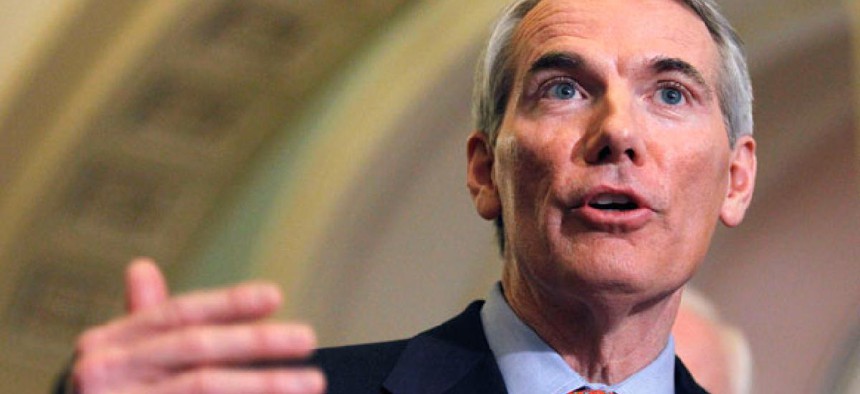
Sen. Rob Portman, R-Ohio Alex Brandon/AP
Contractors remain a focal point in cost-cutting efforts
Senators and agency officials highlight financial benefits of insourcing and proper auditing.
As the government continues to search high and low for cost-cutting initiatives, Congress has turned its eye on federal contractors.
At a hearing Thursday before the Senate Homeland Security and Governmental Affairs Ad Hoc Subcommittee on Contracting Oversight, representatives from the Army, Office of Personnel Management and Homeland Security Department discussed how reducing their dependence on contractors and getting a better handle on expenses can lead to savings.
“The government simply doesn’t have the information it needs to make smart choices,” subcommittee chairwoman Sen. Claire McCaskill, D-Mo., said in her opening remarks, explaining agencies have for years been operating under the assumption that contractors inherently are less expensive than federal workers.
Subcommittee ranking member Sen. Rob Portman, R-Ohio, said the federal government spends $320 billion annually on service contracts and fails to take competition into account when making purchasing decisions. The Office of Management and Budget declined to send a representative to the hearing.
Senators were particularly critical of defense procurement, which makes up 70 percent of all government contracting, according to the Center for American Progress. In 2009, the Defense Department began a voluntary insourcing initiative.
“Anybody who believes we cannot find savings in the Department of Defense contracting does not know the issue,” McCaskill said.
McCaskill praised Jay Aranowitz, the Army’s deputy assistant secretary for force management, manpower and resources, saying the service’s work on contractor inventory “is setting a standard” for the rest of Defense. The Army reduced its contract services obligations from $51 billion in fiscal 2008 to $36 billion in fiscal 2010, according to Aranowitz’s testimony. Aranowitz told the subcommittee, however, that contracts are not integrated into the Army’s overall budget, though the service is working to change that.
Debra Tomchek, executive director of the Homeland Security Department’s Balanced Workforce Program Management Office, touted a strategy formed in mid-2010 to ensure DHS was establishing a proper balance of contractor and inherently governmental work. Under the Balanced Workforce Program, the department identified $2.3 million in savings as of January 2012, Tomchek said in written testimony.
Yet there’s still a way to go. Separately, Pratap Chatterjee, Center for American Progress visiting fellow on government procurement, authored three studies on contracting published Wednesday. He said the disorganized, unchecked nature of contractor auditing leads to a propagation of wasted government resources.
“There’s some fraud and there’s a lot of waste and there’s a lot of abuse,” Chatterjee told Government Executive. “One part of the government has no idea what the other part of the government is doing.”
The problem, he said, stems from multiple uncoordinated contractor accountability databases within government, from the Excluded Parties List System to the Past Performance Information Retrieval System to the Federal Awarding Performance Integrity Information System.
Additionally, Chatterjee said, because most contracts come from Defense, the Defense Contract Audit Agency handles the lion’s share of all federal contracting audits. Since DCAA is nestled within the Pentagon, it is unable to maintain proper independence when making decisions about the fiscal responsibility of military contractors, he said.
Chatterjee would instead like to see a new Federal Contract Audit Agency, which would reside outside the Pentagon, allowing it to maintain independence when attempting to recover taxpayer dollars contractors spent improperly. However, he did not formally recommend such an agency in his report.
In written testimony submitted to the Senate subcommittee, American Federation of Government Employees President John Gage recommended stronger enforcement over excessive contractor compensation and proper federal insourcing.
“This administration, like its predecessors, is unwilling to enforce the relevant sourcing and workforce management laws,” Gage said in his testimony.
According to McCaskill, the current cap on the amount the government will reimburse a contractor for top executives’ salaries is set at $693,000 per year, though legislation is circulating to reduce the limit to $400,000 annually. National Treasury Employees Union President Colleen Kelley warned against such “exorbitant” salaries in her written testimony to the subcommittee.






